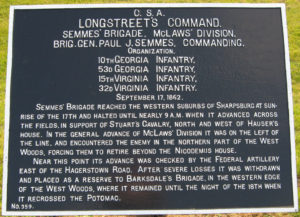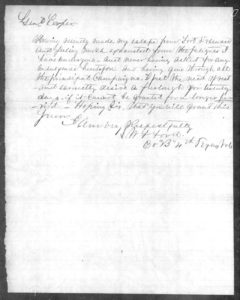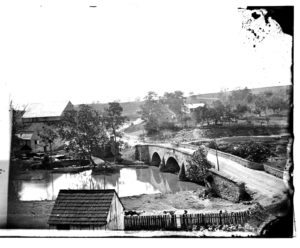Old Man Guest
21 February 2022
Benjamin Franklin Guest was at least 55 years old when he was killed in the battle at Sharpsburg in September 1862; a Private in Company F, 53rd Georgia Infantry.
His is indeed a hard-luck story.
Family history, supported by the US Census, says he lost his Madison County, GA farm and his family due to his drinking, and by 1860 was living alone, an overseer on a farm in Griffin, Spalding County, GA. In May 1862 he signed-up as a substitute for one R.A. McDonald (possibly Robert Alexander McDonald, 1831-1904) of Company F.
The family story says he was killed by a “sniper” on 16 September at Sharpsburg, which is somewhat unlikely, as the 53rd Georgia and the rest of the Brigade arrived at Sharpsburg from Harpers Ferry at sunrise on the 17th. His very brief military record says he was killed on 17 September.
I don’t have a birth year for every soldier killed at Sharpsburg, but among those I do have, Guest is the 2nd oldest. The oldest being Private Adam Burkel of the 11th Pennsylvania Infantry – who was about 57 years old at Antietam.
———————–
The photograph of Semmes’ Brigade’s battlefield tablet was taken by Craig Swain for the Historical Marker Database (HMDB).
Fighting them twice at Sharpsburg
19 December 2021
Private William F. Ford of the Tom Green Rifles, Company B, 4th Texas Infantry had an extraordinary war.
At Sharpsburg on 17 September 1862 he and his regiment were part of Hood’s Division’s devastating charge into Miller’s cornfield early that morning. But that wasn’t enough for Ford.
… after the Brigade was relieved about 10 o’clock am, he was sent off and accidentally meeting the 9th Georgia Regt. reported to Capt King of Co “K” and fought with them till night. Capt King gave him a certificate complimenting him for his gallant conduct thro’ the the day, which certificate was endorsed by both the Col commanding the 9th Georgia Regt and Col Anderson – now Brigadier – commanding the Brigade …
He was captured at Gettysburg in July 1863 and sent to the US prison at Fort Delaware. From which he escaped in August or early September. Not an easy thing, as shown by the fate of Hoxey Whiteside, Company G of the 4th Texas, who attempted such an escape a couple of months after Ford, in November 1863, but drowned in the Delaware River.
Private Ford “passed through parts of Delaware, New Jersey, and Maryland in the disguise of a citizen, arriving safely in Richmond” and, not a shy man, made a request for a furlough directly to the CSA’s Adjutant General, General Samuel Cooper – “hoping sir, that you will grant this favor.” Cooper did.
He was commissioned Junior 2nd Lieutenant of his Company on 1 April 1864 “for valor and skill” and distinguished himself in combat again, in the Wilderness of Virginia, where he was wounded in the leg on 6 May 1864. He was promoted to Senior 2nd Lieutenant on 16 June.
In addition to all this, his is the second case [first, here] I’ve found of a Confederate officer applying to raise and command a “negro regiment.”
He made that request on about 12 March 1865 through his military chain of command, and a week later wrote to John H Reagan, the Postmaster General of the Confederate States, asking for help in expediting it.
Reagan forward a positive recommendation to Secretary of War Breckenridge on 22 March. The reply came back the same day (cover below).
Res. ret’d to the Post Master General. The application has not reached us, but the Dept. has decided not to grant authority to recruit larger organizations of col’d troops than companies except where a battalion of four companies can be raised from one estate.
By com’d Sec. War:
[Captain] John W. Riely, AAG
Word got to Lieutenant Ford on 30 March 1865. It was largely a moot point by then, anyway – Federal troops entered Richmond 4 days later.
He was surrendered and paroled at Appomattox Court House, VA on 9 April 1865, and went home to Austin, Texas. He died there in 1875.
Killed by guerillas
30 October 2021
I found a couple of excellent accounts which nicely bracket the military career of Captain Samuel A. McKee, 2nd United States Infantry. They are too good not to share and I hope both of my readers will appreciate them.
McKee was commissioned 2nd Lieutenant, USA on 5 August 1861 and First Lieutenant 5 days later.
He led Company I of the 2nd US at Antietam, part of a consolidated battalion of companies from the 2nd and 10th United States Infantry regiments. They crossed the creek over the middle bridge about midday on 17 September 1862 and pushed a line of skirmishers up the pike toward Sharpsburg.
Battalion commander Lieutenant John Poland reported “Lieutenant McKee, commanding Companies I and A, Second Infantry, while deploying to the front, was severely wounded and compelled to leave the field.”





